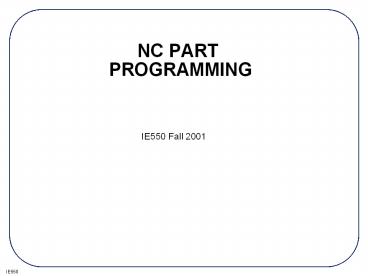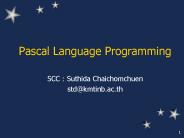NC PART PROGRAMMING - PowerPoint PPT Presentation
Title:
NC PART PROGRAMMING
Description:
NC PART. PROGRAMMING. IE550 Fall 2001. IE550. HISTORICAL ... Write an NC part program to make the ... PART PROGRAMMING. Machine-oriented languages ... – PowerPoint PPT presentation
Number of Views:1083
Avg rating:3.0/5.0
Title: NC PART PROGRAMMING
1
NC PART PROGRAMMING
IE550 Fall 2001
2
HISTORICAL DEVELOPMENT
- 15th century - machining metal.
- 18th century - industrialization,
production-type machine tools. - 20th century - F.W. Taylor - tool metal - HSS
- Automated production equipment -
- Screw machines
- Transfer lines
- Assembly lines
- ...
- using cams and preset stops
- Programmable automation -
- NC
- PLC
- Robots
3
NEW NCs or CNCs
high speed spindle (gt 20,000 rpm) high feed
rate drive ( gt 600 ipm) high precision ( lt
0.0001" accuracy)
4
NC MACHINES
- Computer control
- Servo axis control
- Tool changers
- Pallet changers
- On-machine programming
- Data communication
- Graphical interface
MCU - Machine control unit CLU - Control-loops
unit DPU - Data processing unit
Machine Tool
MCU
CLU DPU
5
NC MOTION-CONTROL
6
NC MACHINE CLASSIFICATIONS
- 1. Motion control point to point (PTP)
- and continuous (contouring) path
- 2. Control loops open loop and closed loop
- 3. Power drives hydraulic, electric,
- or pneumatic
- 4. Positioning systems incremental and
- absolute positioning
- 5. Hardwired NC and softwired Computer
- Numerical Control (CNC)
7
POINT TO POINT
Moving at maximum rate from point to point.
Accuracy of the destination is important but not
the path. Drilling is a good application.
8
CONTINUOUS PATH
- Controls both the displacement and the velocity.
- Machining profiles.
- Precise control.
- Use linear and circular interpolators.
9
MAJOR COMPONENTS OF AN NC MACHINE TOOL
10
NC MACHINE RATING
- Accuracy
- Repeatability
- Spindle and axis motor horsepower
- Number of controlled axes
- Dimension of workspace
- Features of the machine and the controller.
11
NC ACCURACY AND REPEATABILITY
- Accuracy control instrumentation resolution
and hardware accuracy. - Control resolution the minimum length
distinguishable by the control unit (BLU). - Hardware inaccuracies are caused by physical
machine errors.
12
HARDWARE INACCURACIES
- Component tolerances
- inaccuracies in the machine elements,
machine-tool assembly errors, spindle runout, and
leadscrew backlash. - Machine operation
- Tool deflection (a function of the cutting
force), produces dimensional error and chatter
marks on the finished part. - Thermal error
- heat generated by the motor operation, cutting
process, friction on the ways and bearings, etc.
Use cutting fluids, locating drive motors away
from the center of a machine, and reducing
friction from the ways and bearings
13
REPEATABILITY
14
LEADSCREWS
Converting the rotational motion of the motors to
a linear motion.
Nut
Leadscrew
Pitch
- pitch (p) the distance between adjacent screw
threads - the number of teeth per inch (n)
- n 1 / p
- BLU Basic Length Unit (machine resolution)
- BLU p / N
- e.g. an NC machine uses a 0.1" pitch leadscrew
and a 100 pulse/rev encoder. - BLU p / N 0.1 (in/rev) /100 (pulses/rev)
0.001"
15
CONTROL LOOPS
- Open loop - No position feedback.
- Use stepping motor.
- A machine has 1 BLU 0.001".To move the table
5" on X axis at a speed (feed rate) of 6 ipm. - pulse rate speed/BLU 6 ipm/0.001 ipp 6,000
pulse/min - pulse count distance/BLU 5/0.001 5,000
pulses
table
motor
pulses
16
CLOSED LOOP
Closed-loop control mechanism
17
INTERPOLATION
- Control multiple axes simultaneously to move on a
line, a circle, or a curve.
Point-to-point control path
Linear path
18
INTERPOLATORS
- Most common interpolators are linear and
circular - Since interpolation is right above the servo
level, speed is critical, and the process must
not involve excessive computation. - Traditional NC interpolators Digital
Differential Analyzer (DDA) - Higher order curves, such as Bezier's curve, use
off-line approximation algorithms to break the
curves into linear or circular segments.
19
COORDINATE SYSTEMS
- Right hand rule
- Z axis align with the spindle - Z moves away
from the workpiece or the spindle. - X axis - Lathe perpendicular to the spindle.
- Horizontal machine parallel to the table.
- Vertical machine X points to the right.
20
MACHINE COORDINATES
Z
X - Primary Feed axis Z - Spindle axis Y -
Remaining axis
Y
X
21
PROGRAM STORAGE
- Paper tape
- Paper or Mylar coated paper.
- Diskettes
- From other computers through RS 232 or local
area network (LAN)
22
SYMBOLIC CODES
- ASCII or ISO, use even parity
- EIA - Binary Coded Decimal (BCD), RS 244A
standard, use odd parity.
23
TAPE INPUT FORMATS
- EIA RS-274 standard
- Fixed sequential format
- 0010 01 07500 06250 00000 00000 612
- Tab sequential format
- T0010 T01 T07500 T06250 T T T612
- Word-address format
- N0010 G01 X07500 Y06250 S612
24
NC WORDS
- A G-code program consists the following words
- N, G, X, Y, Z, A, B, C, I, J, K, F, S, T, R, M
- An EIA standard, RS-273 defines a set of standard
codes.
25
BASIC REQUIREMENT OF NC MACHINE CONTROL
- a. Preparatory functions which unit, which
interpolator, absolute or incremental
programming, which circular interpolation plane,
cutter compensation, etc. - b. Coordinates three translational, and three
rotational axes. - c. Machining parameters feed, and speed.
- d. Tool control tool diameter, next tool number,
tool change. - e. Cycle functions drill cycle, ream cycle, bore
cycle, mill cycle, clearance plane. - f. Coolant control coolant on/off, flood, mist.
- g. Miscellaneous control spindle on/off, tape
rewind, spindle rotation direction, pallet
change, clamps control, etc. - h. Interpolators linear, circular interpolation
26
NC WORDS
- N code. sequence number
- N0010
- G code. preparatory word.
27
NC WORDS (continue)
- X, Y, Z, A, B, C Codes. coordinate positions of
the tool. - The coordinates may be specified in decimal
number (Decimal Programming), or integer number
(BLU Programming). - BLU programming leading zero, trailing zero.
- In the leading zero format
- X00112 Y002275 Z001
- In the trailing zero format, the program looks
like - X11200 Y22750 Z10000
28
NC WORDS (continue)
Circular Interpolation
Full circle ON
(5.000,4.000)
N0100 G02 X7.000 Y2.000 I5.000 J2.000
Cut from (5.000,4.000) to
(7.000,2.000) CW
(7.000,2.000)
(5.000,2.000)
29
NC WORDS (continue)
- F Code. feed speed.
- inch/min (ipm), or ipr.
- F code must be given before either G01, G02, or
G03 can be used. - N0100 G02 X7.000 Y2.000 I5.000 J2.000 F6.00
- S Code. cutting speed code.
- It is programmed in rpm.
- S code does not turn on the spindle, spindle is
turned on by a M code. - N0010 S1000
30
NC WORDS (continue)
- T Code. tool number.
- Actual tool change does not occur until a tool
change M code is specified. - R Code. cycle parameter.
The cycle may be programmed in one block, such
as (cycle programming is vendor
specific.) N0010 G81 X1.000 Y2.000 Z0.000 R 1.300
31
NC WORDS (continue)
M Code. miscellaneous word.
32
MANUAL PART PROGRAMMING
- Example 9.1
- Machined from a 5" x 4" x 2" workpiece. low
carbon steel. - The process plan
- 1. Set the lower left bottom corner of the part
as the machine zero point (floating zero
programming). - 2. Clamp the workpiece in a vise.
- 3. Mill the slot with a 3/4" four flute flat end
mill made of carbide. From the machinability
data handbook, the recommended feed is 0.005
inch/tooth/rev, and the recommended cutting speed
is 620 fpm. - 4. Drill two holes with a 0.75" dia twist drill.
Use 0.18 ipr feed and 100 fpm speed.
33
PART DRAWING
A
l
l
d
i
m
e
n
s
i
o
n
i
n
i
n
c
h
e
s
.
A
l
l
t
o
l
e
r
a
n
c
e
0
.
0
0
1
"
34
SOLUTION TO EXAMPLE
- Solution
- The cutting parameters need be converted into
rpm and ipm. - Milling
- Drilling
RPM
3,157
rpm
RPM
509
rpm
35
SETUP AND CUTTER PATH
36
CUTTER LOCATIONS
- The coordinates of each point (cutter location)
are calculated below - p1' ( 1.750.375, -0.1-0.375, 4.00) (2.125,
-0.475, 4.000) - p1 (2.125,-0.475, 2.000-0.500)
(2.125,-0.475,1.500) - p2 (2.125,4.0000.100,1.500)
(2.125,4.100,1.500) - p3 (3.000-0.375,4.100,1.500)
(2.625,4.100,1.500) - p4 (2.625,1.375,1.500)
- p5 (3.000,2.000-1.0000.375,1.500)
(3.000,1.375,1.500) - p6 (3.000,2.625,1.500)
- p7 (3.000,2.000,1.500)
- p8 (2.625,2.000,1.500)
- p9 (2.625,-0.100,1.500)
- p9' (2.625,-0.100,4.000)
37
PART PROGRAM
- Part program Explanation
- N0010 G70 G 90 T08 M06 Set the machine to inch
format - and absolute dimension programming.
- N0020 G00 X2.125 Y-0.475 Z4.000 S3157 Rapid to
p1'. - N0030 G01 Z1.500 F63 M03 Down feed to p1,
spindle CW. - N0040 G01 Y4.100 Feed to p2.
- N0050 G01 X2.625 To p3.
- N0060 G01 Y1.375 To p4.
- N0070 G01 X3.000 To p5.
- N0080 G03 Y2.625 I3.000 J2.000 Circular
interpolation to p6. - N0090 G01 Y2.000 To p7.
- N0100 G01 X2.625 To p8.
- N0110 G01 Y-0.100 To p9
- N0120 G00 Z4.000 T02 M05 To p9', spindle off,
tool 2. - N0130 F9.16 S509 M06 Tool change, set new feed
and speed. - N0140 G81 X0.750 Y1.000 Z-0.1 R2.100 M03 Drill
hole 1. - N0150 G81 X0.750 Y3.000 Z-0.1 R2.100 Drill hole
2. - N0160 G00 X-1.000 Y-1.000 M30 Move to home
position, stop
38
CNCS VERIFICATION
39
CNCS 3D DRAWING
40
TOOL-RADIUS COMPENSATION
- Start of Compensation.
- G41 (or G42) and G01 in the same block ramp takes
place at block N0010. - N0010 G01 G42 X0.500 Y1.700
- N0020 G01 X1.500
- G41 (or G42) and G01 in separate blocks the
compensation is effective from the start. - N0010 G41
- N0020 G01 X0.500 Y1.700
- N0030 G01 X1.500
(0.5, 1.7)
(1.5, 1.7)
G41
G42
41
TOOL-RADIUS COMPENSATION
- Inside Corner.
- Cutter path is inside a corner, stops at the
inside cutting point - N0010 G41
- N0020 G01 X1.500 Y2.000
- N0030 G01 X0.000 Y1.600
- Use of M96 and M97.
- Cutting tool that is larger than the height of
the step, M97 must be used - N0010 G41
- N0020 G01 X1.000 Y1.000
- N0030 G01 Y0.800 M97
- N0040 G01 X2.000
(1.5, 2.0)
(0, 1.6)
42
TOOL-RADIUS COMPENSATION
- Cancel Tool Compensation.
- G40 in the same block ramp off block.
- N0060 G40 X2.000 Y1.700 M02
- G40 in a block following the last motion, the
compensation is effective to the end point
(2.000,1.700). - N0060 X2.000 Y1.700
- N0070 G40 M02
(2.000, 1.700)
(2.000, 1.700)
43
EXAMPLE
- A square 2.0 in. x 2.0 in. is to be milled using
a 1/2 in. end milling cutter. Write an NC part
program to make the square. - Solution
- Let us set up the lower left corner of the
square at (6.0,6.0). Using tool-radius
compensation, the square can be produced.
44
PART PROGRAM
45
TURNING
Part design
Cutter path
46
TURNING
Programming tool point
No compensation needed.
Surfaces cut
Programmed tool path
Surface created
47
COMPUTER ASSISTEDPART PROGRAMMING
- Machine-oriented languages - machine specific
- General-purpose languages - use post processors
to generate - machine specific code
- Translate input symbols
- Arithmetic calculation
- Cutter offset calculations
- Post processing
Part program
Language Processor
CL data
Post Processor
CL BCL
RS-494
N-G code
RS-273































